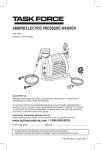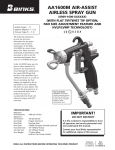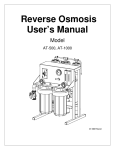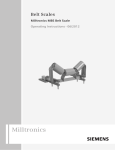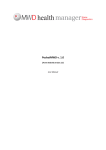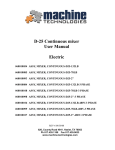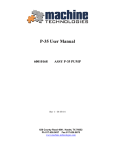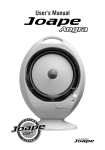Download D-35 Silo mixer User Manual Electric
Transcript
D-35 Silo mixer User Manual Electric #60010166 D-35 SILO-MIX - 220V 1 phase #60010167 D-35 CONT-MIX - 220V 1 phase #60010178 D-35 SILO-MIX - 220V 3 phase #60010179 D-35 CONT-MIX - 220V 3 phase Page 1 Dear Customer, Before starting this machine please complete the following; Machine Date of purchase………………………………….. Machine serial number……………………………………… Please read the following information contained within this manual and fully familiarize yourself with the equipment. Page 2 Contents Page Section 1 - General Safety information.........................................................................4 Danger ........................................................................................................................4 Section 2 - Machine Description ...................................................................................5 Function......................................................................................................................5 Machine illustrations..................................................................................................6 Machine – silo mounted shown...............................................................................6 Machine - View facing left ......................................................................................7 Machine - View facing right ...................................................................................8 Machine – control panel .........................................................................................9 Machine – Water system.......................................................................................10 Machine – Water system-cont ..............................................................................11 Machine - Nozzle Assembly ..................................................................................12 Machine – Drive line, feed liner and feed screw ..................................................13 Machine – Main body and butterfly valve ...........................................................14 Section 3 – Unpacking and Machine assembly...........................................................15 Section 4 – Machine set up and operation ..................................................................21 Machine control panel operation - explained..........................................................21 Electrical connections, and first start up.................................................................22 General operation ....................................................................................................23 Start up..................................................................................................................23 Shut down..............................................................................................................23 Operational notes .....................................................................................................24 Section 6 – Maintenance..............................................................................................25 General notes............................................................................................................25 Feed screw removal..................................................................................................26 Mixing shaft separation ...........................................................................................27 Wear parts................................................................................................................28 LIMITED WARRANTY POLICY............................................................................29 Page 3 Section 1 - General Safety information Danger Follow these instructions very carefully, in order to avoid injury to yourself or others. Electrically powered machine. Always ensure that all power to the machine has been turned off and isolated before ANY maintenance / repair work is carried out on the machine. Ensure that all guards are correctly fitted before starting or attempting to operate the machine. Ensure that all fasteners are present and correctly fitted before attempting to start or operate the machine. Ensure that the nozzle unit is correctly fastened to the front of the mixer unit of the machine, and free of damage before attempting to start or operate the machine. Ensure that the breaker assembly is free to rotate within the nozzle assembly prior to starting the machine. The D-35 continuous mixer unit can produce high torques and can use high voltages. Care must be taken by authorized persons when using and working with this machine. Page 4 Section 2 - Machine Description Function The continuous mixer uses pre blended material, in either silo fed or pre-bagged form, that is poured into the hopper, that then discharges into the nozzle and mixes it with water, to provide a usable mixture at its outlet. The machine has a drive motor, which turns a drive shaft within a material hopper that in turn rotates a helical feed screw, in turn rotating a mixing shaft. The combination of these shafts and mixing components move material from the hopper through to the mixing nozzle, that with the addition of an adjustable water control that hydrates the mixture to the desired level. The mixing tines in the nozzle tube, mix and shear the material so that once it emerges from the discharge aperture, the mixture is correctly mixed and sheared ready for use or for pumping to the application. The machine is driven by an electric motor powered by 3 phase voltage, via an electronic variable speed inverter supplied by two phase 208-240 VAC 50/60Hz, alternately 208240 VAC 3 Phase or 440/480 VAC 3phase. Input power. The inverter control box allows the user to adjust the speed of rotation in three preset steps (these step points are factory set but can be adjusted to suit the individuals requirements – please consult Machine Technologies for more information) combined with the volumetric displacement per rev of the feed screw, to provide the required “flow” of material. The control box also contains controls for the water system that operates when the unit is started in the “feed” direction. If the unit is reversed for any reason the water feed will turn off, and then turn back on once the reverse knob is released. The water control system contains a water pump, pressure regulator, a control valve, pressure switch and a visual water flow meter. The flow of water from the meter into the mixing nozzle is adjustable via the control knob at the meters base. Turning clockwise slows the flow rate, counter clockwise increases the flow. A vibrator power feed is provided on the side of the control panel to connect to a vibrator control box and vibrator, designed to be fitted to a silo or hopper needing vibration The difference between the machines is primarily the input voltage / phase, but additionally, different dosing screws are available allowing an additional variation of material output, for the same pre-set speeds. Page 5 Machine illustrations Machine – silo mounted shown. Page 6 Machine - View facing left 1 – NOZZLE ASSY 2 – MIXER BODY 3 – BUTTERFLY VALVE 4 – CONTROL PANEL 5 – PANEL SURROUND 6- WATER SYSTEM Page 7 Machine - View facing right 7- MOTOR GEARBOX. 8 – MOTOR HINGE 9 – ASSEMBLY WEDGE. Page 8 Machine – control panel The base frame can be re-configured to have the wheels, axle etc. located at the opposite end of the unit, with the handle thus also being mirrored. The control panel assembly on handle assembly can be moved, by pulling the pins keeping the handle assembly in place in the frame, then sliding the handle out, allowing access to the control box itself 1 – Base frame 5 – Wheel / Tire 2 – Handle 3 – Axle lock Page 9 4 – Axle Machine – Water system Page 10 Machine – Water system-cont Page 11 Machine - Nozzle Assembly 1 – MIXING TUBE ASSY 2 – MIXING SHAFT ASSY 3 – MIXING TUBE DISCHARGE ASSY 4 – LOCKING WEDGE (4) Page 12 Machine – Drive line, feed liner and feed screw 1 – Motor gearbox, 2 – Feed screw, 3 - Feed liner, 4 – Liner retainer, 5 –pin & clip 6 – Motor hinge plate, 7 – locking wedge, 8 – Motor adapter/breather, 9 – poly seal 10 – Clamp plate, 11 – Drive Auger, 12 – fixing bolt (4) Page 13 Machine – Main body and butterfly valve 1 – Main body, 2 – flange gasket, 3 – butterfly valve, 4 – ½”-13 thin locknut, 5 – ½” plain washer, 6 – ½”-13 x 1 ½” full thread hex bolt Page 14 Section 3 – Unpacking and Machine assembly Typical pallet packaging Upon, delivery remove the contents of the shipment and assemble per the previous illustrations. Page 15 Assemble the main body, inclusive of the feed liner and the butterfly valve, to the lower flange of your silo. The use of a fork lift to help in this process is recommended. Ensure that the operating lever of the butterfly valve can rotate throughout its range without hitting the silo base, the control panel assembly the main body, or any other fixed item. NOTE, that the swivel ring side of the valve must face the main body of the mixer, or the flap disc will not open fully. The disc pivot is off center in the butterfly valve, the pivot should be closer to the silo side and further from the main body of the mixer Once the main body and the butterfly valve have been secured using the 16 bolts, washers and nuts, then the motor assembly must be affixed to the pivot block using the hinge pin. Page 16 Once the motor assembly has been fitted and the pivot pin secured, it might be necessary to adjust the eye bolts on the motor mounting plate to ensure that the plate closes snugly against the open end of the main body When closing the motor plate you will have to support the end of the drive shaft and rotating to align correctly with the drive auger Page 17 Once closed then the locking wedge must be inserted and hammered lightly into place to secure the assembly and maintain the drive shaft engagement. Assemble the nozzle assembly to the front of the main body, and hammer into place the two wedges to hold the assembly to the main body Page 18 Insert the mixing shaft into the nozzle, rotating the shaft as it is slid towards the main body. The tapered end of the shaft will locate into the hole in the end of the feed shaft and eventually due to the rotation, the drive pin will align with the slot in the feed shaft and rotation will become a lot harder, in turn actually turning the motor shaft. Assemble the nozzle assembly to the front of the mixing tube and secure with the wedges. Ensure that the mixing shaft end locates into the plastic bushing in the end of the nozzle assembly. Page 19 Hang the main control panel assembly on the side of the main body, by engaging the “hooks” into the slit cut outs on the top of the main body and then align and pin the rear bracket with the corresponding feature on the main body. Insert the water feed pipe into the opening in the main body molding of the feed liner Page 20 Section 4 – Machine set up and operation Machine control panel operation - explained The electronic Drive module comprises of a variable speed frequency inverter, allowing the use of 220VAC two or three phase to run the high torque 3 Phase gear motor. The unit is rated at 4KW providing plenty of power to run the D-35 unit. The module is supplied with an input plug and 50’ of cable allowing immediate wiring into your own 220VAC supply (Must be carried out by an approved installer). The motor is supplied with a pre-wired plug that fits into the 3 Phase outlet of the module. The module has a main power isolator, a combined stop / start switch, a spring return reverse switch, a 3 position speed control selector switch, a water pump ON/OFF switch, a water prime push button, illuminated indicators showing the state of adequate water pressure, inverter fault condition and main power ON, internal breakers, for each input phase, and a large capacity cooling fan in addition to the fan fitted to the inverter. The module also has outputs / connections for the water pressure switch, the water pump feed, the water solenoid feed, a remote socket, providing the optional capability for remote operation, and an optional 220v 60hz vibrator connector socket. Upon delivery, the inverter drive inside the control box is pre-configured to suit your machine, the configuration can however be altered to specifically suit many special needs regarding torques, and speed selections. For information on these topics please contact Machine Technologies directly. The machine will not run without water pressure, or a water pressure present signal. There is a “dummy plug” for the water pressure switch used for diagnostic purposes which mimics the water pressure present signal. Once water pressure is present then the water PSI light illuminates and the machine becomes functional when the “start” button is pressed. When the machine is running, the water solenoid is also energized and water will flow through the system into the feed liner, then into the mixing tube. When the reverse switch is applied, the motor will decelerate to stop then reverse and accelerate to the selected speed. While the unit is reversing the water solenoid is de-energized and water will not flow. The machine can be operated using a wired remote controller which gives control over the start and stop functions of the machine only. The remote is connected by removing the remote “dummy plug”. The machine will NOT function without either the dummy plug, or the wired remote fitted to the remote socket connector on the control box. Page 21 Electrical connections, and first start up 1. Ensure that there are no power connections to the Electronic drive module. 2. Connect the motor power plug into the socket on the control box. 3. Ensure that the water solenoid connector from the control box is plugged onto the water solenoid coil. 4. Ensure that the water drain cock is closed 5. Commission your licensed electrician to connect the supplied 50’ power cord with connection socket to the electrical supply, ensure that the supply voltage and phases are the same as the control panel supplied. 6. Ensure that the drive module rotary isolator switch is turned OFF, and connect the socket to the control panel. 7. Have the electrician replace the breakers into the distribution box, onto the bus bar and turn them ON. 8. Turn the drive module isolator to ON, and listen for the cooling fan to turn on and the system power light to illuminate. 9. Connect the water hose to the main water system inlet, and turn on the water supply. The following must be conducted by a supervisor or a qualified individual experienced in electro-mechanical equipment. Ensure that there are no persons close to the machine. Ensure that there are no obstructions in or around the machine. Turn the speed selector to position 2 10. Place a catch bucket under the discharge of the mixing nozzle. 11. Check that the water pump is turning in the correct direction, by pressing the prime button, with the flow meter set to 3GPM, then turn on the water pump, and observe the flow rate to increase, if not then the pump is running in reverse. NOTE only the 3 phase water pump can be reversed, by swapping any of the 2 phase wires. 12. Turn on the water pump, and check for water leaks, if no leaks then press the prime button and again check for leaks. If any leaks are found then they should be corrected before continuing. Turn off the water pump. 13. While pressing the prime button and with the water pump running set the water flow on the meter scale to 3 GPM then release the prime button. 14. Press the start button and observe the machine to turn the drive shaft and in turn the mixing shaft inside the nozzle tube. A scraping noise is normal, if heard, being the mixing tines running close to the inside of the tube, for maximum shear effect, and water will be passed through the mixing tube out to the discharge end 15. Turn the direction switch from FWD to REV observe the machine to turn the shaft and in turn the mixing shaft, in reverse, and the water feed to stop. 16. Press the stop button. 17. Turn off the water pump. NOTE – never leave the water pump running with no water flow through the system or damage to the water pump will occur due to overheating. 18. The machine is now ready for use, by trained and qualified operators. Page 22 General operation Start up The following are to be completed by trained and experienced persons, familiar with the mixing system provided. 1. Fill the D-35 hopper with material, by dropping bags over the bag breaker, twisting left and right by approx 15 degrees, then lifting both ends of the bag to tear it in the middle. Allow the material to drop into the hopper, then remove the bag from the grid area into a disposal container. OR Connect the D-35 to a silo, and open the butterfly valve slowly to allow material to drop into the feed section of the main body. 2. Remove the mixing nozzle, the mixing tube, and the mixing shaft from the front of the D-35. 3. Turn the water supply OFF, then press the start button to establish the output of material, by either measuring the output within a certain time, or by weighing the output within a certain time. 4. Once the output is established at the chosen speed, then re-assemble the mixing shaft, the mixing tube and the mixing nozzle to the front of the unit. 5. Turn ON the water supply, and disconnect the hose to the feed liner body. Place the hose end on the ground or in a bucket where water will not damage anything. 6. Calculate the water required to meet the specifications set by the manufacturer, turn on the water pump, press the prime button and set the water meter flow rate to your desired setting, release the prime button. 7. Reconnect the hose to the feed liner body. 8. The machine is now ready for use. Remember, unless used immediately, turn off the water pump to avoid damage. Shut down 1. Run the hopper empty of material or close the butterfly valve while the unit is running (allows the valve to close easier). 2. Allow the unit to continue to run without material but will water still flowing, until clear water flows from the nozzle discharge. 3. Stop the machine, turn off the water pump. 4. Remove the mixing nozzle, mixing tube, and mixing shaft. 5. Inspect the feed screw for material build up, or signs of dampness that might attract material and in turn cause blockages. If damp or contaminated then the feed screw will need to be removed, cleaned and dried. – See maintenance 6. Clean and dry the mixing tube, the mixing shaft and the mixing nozzle, check for signs of damage. Page 23 Operational notes Do not let hopper run below the top of the mixing shaft while mixing or the mix ratios will change. To stop machine push the stop button. Do not remove the finger grate while mixer is running. Do not spray water on or in control box. Control box should be wiped down with a damp rag. Mixer can be disassembled by removing wedges, this facilitates easier transport and final clean up. Always check hoses and cords for wear. The unit runs on high voltage and is capable of high torques. Initially, after 3 hours of operation, check that the feed screw section of the shaft (in the feed liner) is clean at the end sticking from the liner as this is prone to water contamination, and can suffer a material build up. Also check for build up on the mixing shaft and inside the both the tube and the nozzle. Page 24 Section 6 – Maintenance General notes Do not grease any of the mixing shaft connections as the lubricant will attract material and cause premature wear. Check the condition of the mixing shaft parts on a regular basis, and ensure that they fully engage with each other. Check for the level of “play” between parts and replace when they become “loose” or increased levels of wear will occur on other mating parts. Check that all fasteners are fully assembled and tight at all times. Ensure that the water control is free of leaks and that the system is drained if being stored or not used, in freezing conditions. Replace any bent, damaged or torn parts immediately to prevent further damage to the machine and / or personnel. Ensure that the safety finger guard is always replaced after any nozzle maintenance. Check the condition of all electrical connections a shift by shift basis. Clean the whole machine on a shift by shift basis. At the rear of the unit the drive auger runs inside a poly seal, which with time can become worn, allowing material to pass and in turn fall out through the drain slot. Page 25 The drain slot is below the motor flange at the motor hinge plate Feed screw removal Removal of the feed screw is carried out at the rear of the machine. For alignment reasons it is better to remove the feed screw AFTER the mixing shaft has been removed. To remove the feed screw, remove the wedge situated on the hinge plate using a hammer or suitable tool, then “swing” the motor around on the hinge pin to allow access into the rear of the main body. Draw the feed shaft out from the rear, clean, inspect and replace Page 26 Re-engagement of the feed shaft back into the drive auger will require manual alignment, and manual support via ones hand as the hinge plate is re-closed. Re-assembly of the mixing tube, shaft and nozzle is the reverse of disassembly, but assemble the tube to the body first, then the mixing shaft into the tube and in turn the feed screw, then the nozzle. Mixing shaft separation The mixing shaft can be stripped down into individual parts for repair or simple reconfiguration, by the reversal of select ploughs, or the addition of tine bars The mixing shaft is held together by a clamping bolt with a left hand thread at one end Remove the bolt and the various sections can be removed or re-ordered Page 27 Wear parts It is normal for wear to occur on the mixing shaft, and in the mixing nozzle. The rate of wear is very dependant upon the materials being mixed and the throughput of the machine. The feed / metering section of the mixing shaft is also subject to wear, as is the feed liner. The mixing shaft is made of multiple sections each part is individually replaceable. The feed liner is also available a replaceable part, as is the nozzle and the tube. Page 28 LIMITED WARRANTY POLICY Machine Technologies warrants each of its new machines to be free of defects in material and workmanship under normal use and services for a period of one (1) year from the date of delivery. The warranty is issued ONLY to the INITIAL USER. The warranty period begins when the product is delivered to the initial user or when first put into service, whichever occurs first. Said warranty is void if the machine is subject to misuse, neglect, accident or abuse. Machine Technologies’ obligation under this warranty is limited to correcting without charge, at its warehouse, any parts or parts thereof which shall be returned to its warehouse, transportation/shipping prepaid and upon Machine Technologies’ examination proves to have been originally defective. Correction of such defects by repair or replacement shall constitute fulfillment of all obligations to the initial user. This warranty does not include labor or transportation charges unless specifically identified and authorized in writing by Machine Technologies. Nor does the warranty apply to any unit upon which repairs or unauthorized alterations have been made. The warranty does not apply to normal maintenance service or to normal replacement of certain machine parts which are subject to normal wear (including but not limited to pins, bushings, rotors, stators, hoses, spray caps, spray nozzles, mixing shafts, shaft couplings and connectors, dosing shafts, pump shafts, filter elements and tires). THIS IS A LIMITED WARRANTY AND IS IN LIEU OF ANY OTHER WARRANTIES, EXPRESSED OR IMPLIED, INCLUDING ANY WARRANTY OF MERCHANTABILITY OF FITNESS FOR A PARTICULAR PURPOSE. In no event shall Machine Technologies be made liable for incidental, general or consequential damage, loss or any expense directly or indirectly related and resulting from use or lack of use caused by delay in delivery, parts failure, or any other causes associated with the product use. No person, firm or corporation is authorized to assume for Machine Technologies any other liability in connection with the sale of Machine Technologies products. Page 29





























